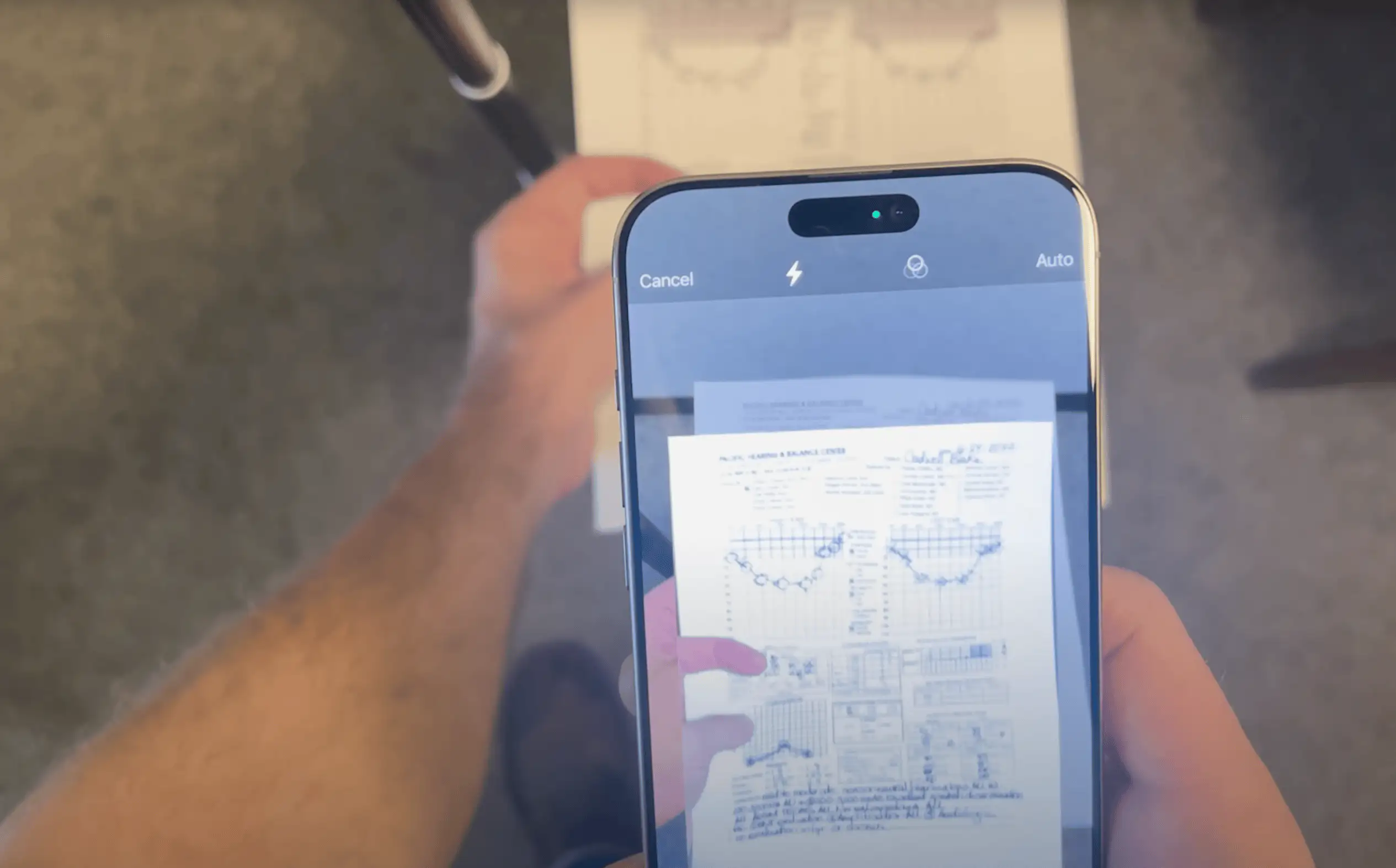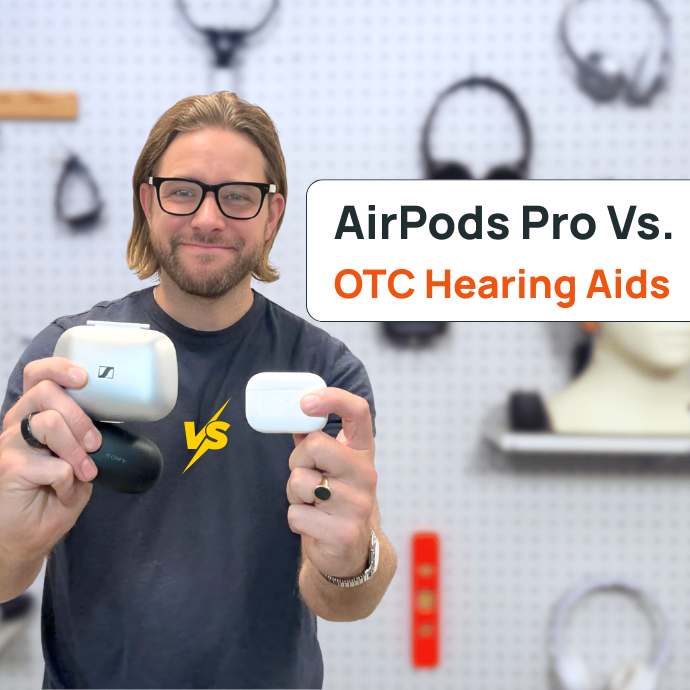Apple’s recent FDA clearance for AirPods Pro 2 as hearing aids has created a lot of buzz—and a fair bit of confusion.
Many of the folks we interact with ask: Should I skip traditional hearing aids and just use AirPods? Can a $250 pair of earbuds really do the job?
After testing AirPods Pro 2 for months alongside traditional over-the-counter (OTC) hearing aids, I’ve landed on a clear answer. But it’s more nuanced, so hang with me.
The short answer? AirPods Pro 2 are an excellent tool for folks with hearing loss—especially for calls and streaming—but they can’t fully replace purpose-built hearing aids for all-day comfort and social settings. Most people I talk to end up using both.
Prefer to watch? Check out our video below👇
- 50+ hearing aid brands reviewed and rated by our team of hearing aid wearers and audiologists
- 200+ hours each month spent researching brands and care options
- 2,000,000 people shopped on Soundly in 2024
- 100% independently owned and operated
Read more about our company, services and process here.
- 50+ hearing aid brands reviewed and rated by our team of hearing aid wearers and audiologists
- 200+ hours each month spent researching brands and care options
- 2,000,000 people shopped on Soundly in 2024
- 100% independently owned and operated
Read more about our company, services and process here.
Featured in this article
How Apple Entered Hearing Health
AirPods Pro 2 represent Apple’s first real step into hearing care—and they’ve done it fast. Just a few years ago, consumer brands like Sony, Sennheiser, and Apple weren’t in this space at all.
That changed in 2022 when the FDA created a new category of hearing aids that could be sold over the counter without a prescription. This regulatory shift opened the door for consumer tech companies to join the hearing health conversation—and Apple went to work.
With the release of iOS 18.1, Apple introduced FDA-cleared hearing aid functionality inside the AirPods Pro 2 (in late 2024). It’s a major milestone, signaling Apple’s deeper commitment to accessible hearing technology.
Here’s how it works:

You take a test through your iPhone that programs the AirPods to match your hearing loss. From there, both outside sound (via Transparency Mode) and streaming audio adjust to your hearing profile.
It’s a classic Apple experience: smooth, intuitive, and genuinely impressive. You can upload an existing audiogram via a photo or take the built-in test. Either way, it takes about 10 minutes.
And at $250, you're also getting a great pair of headphones.
AirPods vs. Hearing Aids: Why It’s Not Apples to Apples
When people ask me to compare AirPods to hearing aids, I often say they belong in different categories. Here's why.
Form Factor: Hybrid Earbud vs. Purpose-Built
- AirPods Pro 2 use the familiar earbud style—visible, but not out of place in an airplane or on the street.
- OTC hearing aids come in a variety of designs:
- Invisible-in-canal options like the Sony CRE-C20
- Behind-the-ear styles like Sennheiser All Day Clear
- Eyeglass-based hearing aids like Nuance Audio, which use open-ear speakers in the frames
- Invisible-in-canal options like the Sony CRE-C20
Your choice impacts comfort, sound quality, and daily usability.
Comfort: Purpose-Built Devices Win Out
This one’s not close. Nearly all of the purpose-built hearing aids I’ve tested are more comfortable for long-term wear than AirPods Pro 2.
Even with various ear tips, I can wear AirPods for about 1.5 hours before they start to feel fatiguing. They’re fine for a podcast or Zoom call—but not for a four-hour dinner or a full workday. Hearing aids are designed to disappear, and that matters.
Battery Life: Purpose-Built Has 4X the Power
- AirPods Pro 2: ~4.5 hours per charge
- Sony CRE-C20: ~28 hours
- Sennheiser All Day Clear: ~18 hours
That’s a big difference if you’re trying to use one device for daily hearing support.
Sound Quality: Great for Streaming, Less So for Social Settings
AirPods Pro 2 do a remarkable job customizing streamed audio to your hearing profile. I love this feature and use it regularly.
But for real-world hearing—especially in noisy or complex environments—they start to break down. There’s more distortion, and the sealed fit means they’re trying to reproduce all the outside sound, rather than simply enhancing it.
In contrast, hearing aids let in some natural sound and selectively enhance what matters—like speech.
Aesthetics: Blending In
AirPods are everywhere. Nobody bats an eye. But in a group setting, people sometimes assume you’re listening to music—not them—unless you explain what’s happening.
Traditional hearing aids, whether invisible or behind-the-ear, are either unnoticeable or signal their true purpose. This makes their use less complicated in social settings.
How I Use Both Products
Here’s how these devices fit into my daily life—and how most Soundly customers tend to use them:
I use AirPods Pro 2 for:
- Podcasts, audiobooks, and music (with customized sound)
- Phone calls on the go
- Quick errands or multitasking
- Travel, when I want to hear announcements and entertainment
I use traditional hearing aids for:
- Social events and group conversations
- Long workdays with back-to-back meetings
- Noisy environments like restaurants or family gatherings
- Times when I want the most natural, nuanced sound
The key insight: They solve different problems. For me—and for many others—it’s not about choosing one or the other. It’s about building a toolkit.
Why Most People End Up Wanting Both
After hundreds of conversations, one pattern is clear: most people who try both end up keeping both.
- AirPods Pro 2 are amazing for quick use and customized streaming.
- Traditional hearing aids are better for comfort, clarity, and daily communication.
And the best part? Getting both still costs less than one pair of prescription hearing aids.
What I’d Do If I Were Starting Fresh
- Start with AirPods Pro 2.
Low-risk. Easy setup. Great learning tool—and great headphones. - Then add traditional hearing aids.
I recommend a behind-the-ear style for most people. It’s more comfortable and offers great sound quality.
Together, these two tools cover nearly every hearing situation I encounter.
Your Next Steps
The good news: you don’t have to commit to just one path.
✅ Start with a hearing test.
Take one online or through a local provider. Knowing your hearing profile will make every other decision easier.
✅ Try OTC hearing aids from a reputable source.
Look for brands with strong return policies (45–100 days) and setup support. That’s where Soundly comes in.
✅ Consider adding AirPods Pro 2.
You’ll learn what kind of support you need—and whether earbuds are enough for you.
Ready to Take the First Step?
🎧 Take our free hearing test to get a snapshot of your hearing profile.
📧 Still have questions? Reach out at hello@soundly.com
📞 Or call us at (833) 768-6359.
We help people navigate these decisions every day—and we’d love to help you find the right fit.






